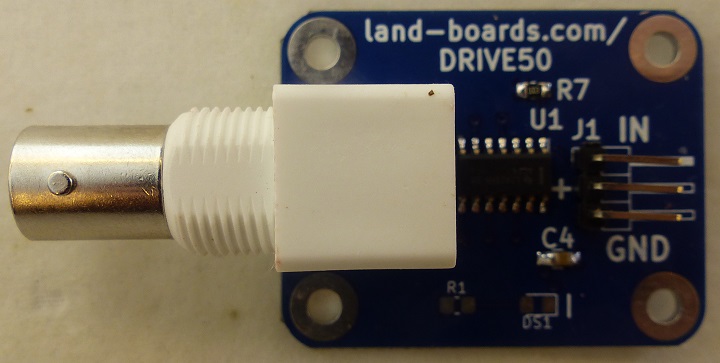Difference between revisions of "DRIVE50"
Jump to navigation
Jump to search
Blwikiadmin (talk | contribs) (→Test) |
Blwikiadmin (talk | contribs) |
||
| Line 1: | Line 1: | ||
| − | [[file: | + | [[file:DRIVE50_P1080480-720PX.jpg]] |
== 50 Ohm Driver Card == | == 50 Ohm Driver Card == | ||
Revision as of 16:02, 30 July 2022
Contents
50 Ohm Driver Card
- "TTL" Level Line driver
- 50 or 75 Ohm output impedance
- BNC or SMA output connector
- 10K pull-up on input
- Card is non-inverting
- 1.5V-5.5V power
- Typically 3.3V or 5V
- 3-pin right angle 0.1" pitch input connector
- (4) 4-40 mounting holes
Driver
- 5x paralleled 74AC14 drivers
- 24mA per pin max current output
- Symmetric high-low drive levels
- Short-circuit proof
- 5V, 250 Ohms to ground is 20 mA (pins are rated for 24 mA
- 24mA per pin max current output
- Card input has single buffer stage
- Schmitt Trigger Input
- 3.3V, 250 Ohm resistors (/5) for 50 Ohm output
- Normal output = 10 mA per pin
Test
- Manual or Automated test
Manual Test Mode
- Supply Vcc 3.3V to 5V and ground
- Input is pulled up to Vcc
- Measure output with BNC T
- Should be 1/2 of Vcc with 50 Ohm terminator
- Should be Vcc without terminator
Automated Test Software
- PulseGen_DRIVE50_Test.py - Tests PulseGen and DRIVE50 cards
- Stored as code.py on QT_Py_(RP2040_based) to auto-run
- Connect 3 pin power cable to card
- Connect BNC T to output of card
- Connect BNC female from tester to BNC T male
- Install 50 terminator to other side of BNC T
- Connect USB C cable
- Display will show
PulseGen/DRIVE50 V1.1 50 Ohm card Set/Got Low Term High = OK
- All 3 LEDs are on

